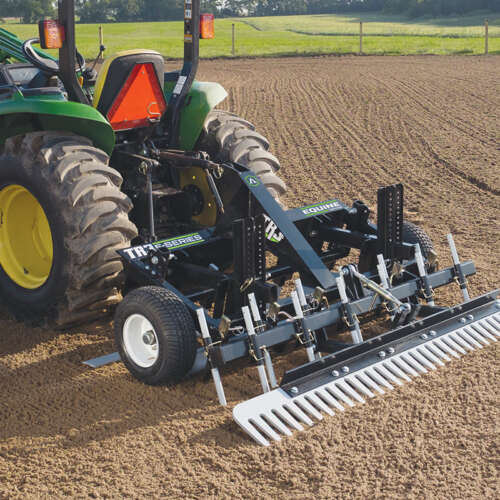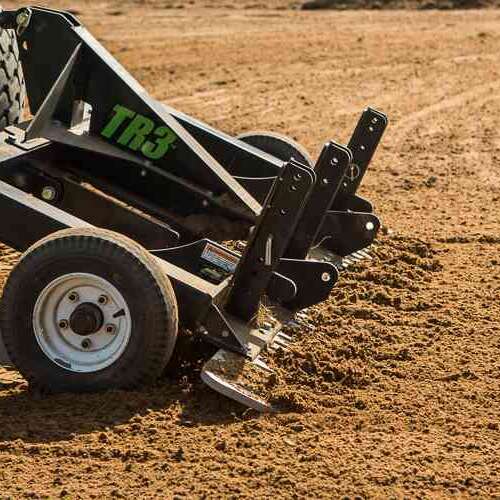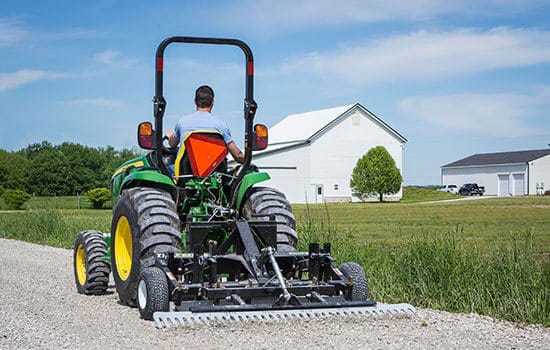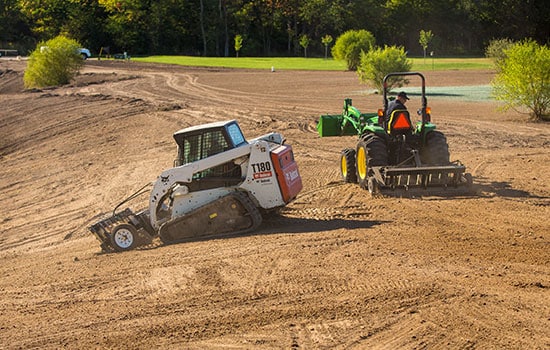TR3 Tires – What’s The Difference? – ABI Dirt
ABI Products Shown In This Video

TR3 “E” Equine Edition
- For Sub-Compact & Compact Tractors, #1 Selling Arena Drag
- 6', 7', 8' Widths
- Starting At: $128/mo.*

TR3 Rake Arena Drag
- For Compact & Utility Tractors, Extreme HD Arena Drag
- 5.5, 6.5', 7.5', 8.5', 10' Widths - Commercial-Duty
- Starting At: $116/mo.*
Transcript
Hi everyone, Matt Metzger here with ABI Attachments and the ABI Dirt. Welcome back to another episode. In today’s episode, we are jumping into part two in our mini series that’s comparing the TR3 and the TR3 E-Series. And on today’s episode, we are going to reinvent the wheel. Now, I know what you’re thinking, that typically, that’s not a good idea, but today we’re actually talking about how a tire, when installed on an ABI Attachments attachment, is not just a tire, it’s a stabilizing wheel, and there’s a big difference, and so let’s talk about in this closer look episode, why stabilizing wheels make such a dramatic impact on your attachments.
If you’re still with me after I told you this episode is going to be about tires, then I know we’re gonna be good friends. But remember I said, it’s not just a tire. When you put the tire on an ABI Attachments, it is a stabilizing wheel. And that’s not just me splitting hairs. The integration of stabilizing wheels on the TR3 line is really significant to how the tool operates. But before we get to the benefits of the application, let’s talk through the design and the specs of the stabilizing wheels on the TR3 and the TR3 E-Series.
So let’s start with the TR3. Here in the TR3, we have got a foam filled, 16 inch wide five lug tire that weighs in at 32 pounds. Now, why so heavy on a three point attachment? Remember, the TR3 was originally designed as a commercial grade product, 10 hours a day, Dawn til dusk, six days a week. So the tires had to be able to keep up. The extra weight, the foam filled, and the durability that that creates allows this to keep up with the rest of the tool. Now, because this tire has to keep up on the work site all day, we made maintenance really easy. On the inside of the hub, you’ve got a grease zerk so you can use a grease gun to keep it moving. You know that also means that the bearings are replaceable. Pop out the dust cap, you can remove the hub off the spindle and you can easily replace the bearings and the races inside.
Now let’s talk adjustability. So if you were to pop off the snap ring that keeps this hub and spindle connected to the TR3, you’ll notice a five hole wheel block adjustment. So, these adjustments on the wheel block give you a number of benefits, first of all, connectivity. So, even though a three point hitch in a tractor has been standardized for years, you have the ability to make some modifications back there. So some of you have a limited the range of motion of your three point hitch. Some of you have made it so that it can’t go quite as low or can’t pick up quite as high, which means there’s some variance there. We created the wheel block here to allow you to move the tires forward and back to make it easier to connect with whatever customizations you’ve got on your three point hitch.
Second reason for the wheel block is depth. You are able to get a greater depth by moving the tires forward, allowing the TR3 to squat down a little bit. Now, that does create something else you need to be aware of, and that’s the third thing, is control of flow. And we’re not gonna talk a lot about material flow right now, a couple of episodes from now, we’re gonna be looking at the finished rig. That’s when we’re gonna dive into material flow through the tool, just know for now that this wheel block allows you to control how much the material is flowing through the tool.
The last benefit of this wheel block is crown control. Now, I know a lot of you are used to using your rear blades where you can both pivot and pitch that rear blade to really move material and create a crown on your gravel drives. Because of these wheel blocks, you now have the ability to do the same thing. So, although a TR3 can’t fully pitch and fully pivot the way the rear blade can, by moving one tire forward and one tire back on the wheel block, you can cause the TR3 to kind of squat at an angle and that will pull material up and allow you to create or maintain a crown on your drive.
Now let’s take a look at the E-Series. You can see that we’ve got an air filled tire on this TR3 E-Series, still 16 inches in diameter, still five lugs on that rim. And it weighs in at just 22 pounds. Now why air filled tires on the TR3 E-Series? Remember the TR3 E-Series was designed just a couple of years ago for residential operations in mind. If you own a TR3 E-Series you probably have a compact or subcompact tractor. So we needed to take a little bit of weight out of the tool. That’s part of the reason going from foam to air. Another reason is we didn’t expect these TR3 E-Series to need to put up with the amount of abuse that a commercial grade TR3 would put up with. But the biggest reason for switching to an air filled tire actually has to do with the application. And we’re gonna talk about in just a little bit.
But let’s talk about maintenance on this TR3 E. Very same as that TR3, inside of this hub, you’re gonna have a grease zerk so you can keep those bearings greased, and, same as the TR3, pop off the dust cap. You can replace those bearings if you need to. A couple of bucks in the local hardware store.
ow we’ll take a look at the adjustability on the TR3 E-Series. So this has the same snap ring pin as the TR3, but you can see, once we pull this tire out of the way that rather than having a five hole wheel block that is in line with the frame, we’ve got a three hole wheel block that runs this depth control vertical. Now the TR3 comes standard, stock from our shop here, in this bottommost hole. This is kind of standard operation. If you need a little bit of depth out of your ground engaging components, you can bump it up to the middle hole. And if you wanna be as aggressive as you can be with this tool, you pop that tire all the way to the top, that allows the tool to get as deep as possible. This wheel block also plays a huge role in the TR3 E-Series‘ ability to crown control. Again, similar to the TR3, where you can angle it differently, on the TR3 series, one tire in the low position and one tire in the high position allows the TR3 E-Series to pivot just a little bit, allowing you to move material and establish a crown on your gravel drive.
I said earlier that on an ABI Attachment, a tire isn’t just a tire, it’s a stabilizing wheel. Whether you’re using the TR3 or the TR3 E-Series, when that stabilizing wheel is on the contour of your ground, the frame is kept at a consistent height, which means your ground engaging components are kept at a consistent depth. You don’t have to worry about your profile blades or scar fires or grooming rods digging any deeper than you want to go, because they can’t go any lower than what the stabilizing wheel will allow. For landscapers, consistent depth and de-compaction of a seed bed means better seed germination, faster results, and higher profitability. For equestrians, having these stabilizing tires in that high sand content arena means a safer ride and better performance for you and your horse. An added benefit of stabilizing wheels is peace of mind when someone else is behind the wheel of the tractor. How many of you have ever let someone who’s green behind the gills, operate the tractor with an attachment on the back? You think they’re a pretty good tractor operator and you’d come back a couple hours later and realize, maybe they needed some more practice. When you’ve got stabilizing wheels, you can set the depth, set your components where you want them and walk away knowing that no one’s gonna be able to rip the material deeper than what you’ve established because of these wheels.
That’s all we’ve got for today, everyone. Hope you found the information beneficial and helpful. Remember, hit that subscribe button, tell all your friends, if you want more information about the TR3 and TR3 E-Series, keep in touch. Until next time, take care.



